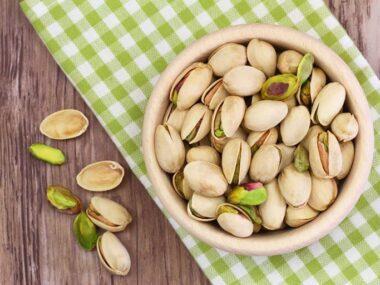In the world of sugary delights, two candies often find themselves in the spotlight: taffy and toffee. These confectionery treats might sound similar, but they are as distinct as night and day. If you’ve ever wondered about the difference between taffy and toffee, you’re in for a delectable journey through the sugary realms of candy making.
What’s Cooking: Ingredients
Let’s begin our exploration with a peek into the culinary composition of these sweet sensations.
Toffee:
Toffee, my friends, is a marriage of sugar, butter, corn syrup, and water. Picture the rich, velvety taste of butter mingling with the sweetness of sugar, and you’re on the right track. But that’s not all – nuts often make a cameo appearance in toffee-making, adding a delightful crunch to this sugary symphony.
Taffy:
On the other side of the candy aisle, taffy takes its form from a blend of sugar, corn syrup, and water. But that’s just the beginning. To give taffy its characteristic flair, cornstarch, food coloring, flavoring agents, and a hint of butter step into the mix. It’s like a rainbow of ingredients coming together to create a chewy masterpiece.
Heat It Up: Temperature Matters
Now, let’s turn up the heat and delve into the temperatures that set these two candies apart.
Toffee:
Toffee takes the road less traveled when it comes to temperature. The sugar syrup for toffee is subjected to some serious heat, reaching the hard crack stage at a scorching 295 to 300 degrees Fahrenheit. This high temperature journey transforms the syrup into a hardened, crunchy delight.
Taffy:
Taffy, on the other hand, opts for a more moderate approach. The sugar syrup for taffy dances to the soft crack stage, where temperatures range from 270 to 290 degrees Fahrenheit. This lower heat preserves its chewy nature while still bringing out its sugary sweetness.
The Art of Taffy Pulling
Here’s where the candy-making process takes a fascinating twist.
Taffy:
Taffy is a candy that’s not just cooked; it’s crafted. After the syrup has cooled enough to handle, it undergoes a mesmerizing transformation. It’s stretched, folded, and pulled, as if it’s participating in a sweet tango. This aeration process infuses air into the taffy, rendering it soft, chewy, and glossy. It’s like sculpting candy art in your own kitchen.
Toffee:
Toffee, in contrast, doesn’t partake in the pulling spectacle. Once it’s poured and cools down, it simply hardens. No stretching, no folding, just a straightforward path to a brittle yet chewy confection.
Texture Talk: Soft vs. Hard
The proof of the pudding is in the eating, they say. So, how do these candies stack up in the texture department?
Taffy:
Taffy boasts a soft, supple texture that’s an absolute delight for your taste buds. It’s the kind of candy that gives your jaw a workout but rewards you with a sweet, chewy sensation. It’s like a sugary cloud you can sink your teeth into.
Toffee:
Toffee, on the other hand, lives up to its reputation of being harder. It’s not rock-hard, mind you, but it’s certainly firmer than taffy. Yet, it manages to retain a chewiness that adds to its appeal. Imagine a harmonious blend of crunch and chew, and you’ve got toffee.
The Art of Taffy-Making
Now that we’ve dissected the differences, let’s dive into the intriguing process of crafting these delectable candies in your very own kitchen.
Making Taffy:
- Gather Your Troops: You’ll need sugar, corn syrup, water, and a touch of butter as your core team members.
- Heat Things Up: Mix your ingredients and set them to simmer in a saucepan. Keep stirring as the temperature climbs to around 270 degrees Fahrenheit, reaching the soft crack stage.
- Flavor Explosion: Once you’ve achieved that perfect temperature, pour the mixture onto a slab and introduce flavor extracts and food coloring for that extra pizzazz.
- Stretch and Fold: Once it cools down enough to handle, it’s showtime! Stretch, fold, and work that taffy to incorporate air until it takes on a silky, chewy texture.
Crafting Toffee:
- Gather Your Ingredients: Sugar, butter, corn syrup, and water are your main actors. If you’re feeling adventurous, toss in some nuts, flavorings, or colorings for added flair.
- Mix and Heat: Combine your ingredients and heat the mixture until it reaches the hard crack stage, flirting with temperatures between 295 to 300 degrees Fahrenheit.
- Cool and Harden: Transfer the bubbling mixture onto a slab and let it cool. As it cools, it transforms into a hardened, crunchy masterpiece with a golden hue.
Beyond Candyland
Taffy and toffee are not just candies; they’re versatile ingredients that can elevate your culinary adventures to new heights.
Toffee:
- Candy Magic: You can savor toffee as a standalone treat, but it’s also a star player in various dessert recipes.
- Pairing Perfection: Pair toffee with other snacks or even dip it in chocolate for an extra layer of decadence.
Taffy:
- Colorful Creations: Taffy’s versatility shines through when it comes to flavors. Experiment with different extracts and food colorings to create a kaleidoscope of taffy flavors.
- Party Pleaser: Taffy is not just candy; it’s a party favor, a treat for kids and adults alike, and a burst of sweet joy.
In Sweet Conclusion
In the grand tapestry of confectionery delights, taffy and toffee, though sounding alike, emerge as unique entities. While they share the spotlight as candies, their differences in ingredients, cooking temperatures, and texture make them stand out in their own sweet way.
So, the next time you indulge in these sugary wonders, take a moment to appreciate the craftsmanship that goes into making each delightful bite. Whether it’s the airy elegance of taffy or the robust crunch of toffee, there’s a sweet surprise waiting in every mouthful.
Remember, candy isn’t just sugar and flavor; it’s a journey through the magical world of culinary artistry. And in this delicious journey, taffy and toffee are stars that shine bright in their own delectable constellation.



